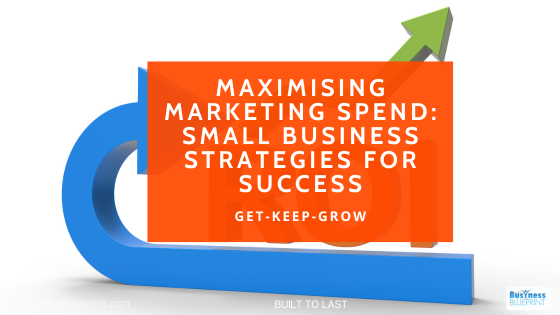In the fast-paced world of business, every dollar counts. As a small to medium-sized business owner, you understand the importance of maximising the return on your marketing expenditure.
This comprehensive guide will walk you through ten actionable strategies to help you achieve just that. By the end, you’ll have a clear roadmap for optimising your marketing efforts and boosting your business’s growth.

#1 Define Clear Marketing Objectives
Your journey towards maximising marketing ROI begins with setting clear, measurable objectives. Establish specific goals aligning with your business vision, whether increasing brand awareness, driving website traffic, or generating leads.
By having well-defined objectives, you’ll steer your marketing efforts precisely and purposefully.
Tips
- Be specific: Clearly define what you want to achieve with your marketing efforts, whether it’s increasing sales by a certain percentage or growing your email subscriber list by a specific number.
- Set measurable goals: Use quantifiable metrics like revenue, leads generated, or website traffic to measure your progress towards your objectives.
- Align with your business goals: Ensure your marketing objectives align with your overall business strategy to maximise their impact.
#2 Understand Your Target Audience
You must intimately know your target audience to make the most of your marketing expenditure. Conduct thorough market research to gain insights into their demographics, pain points, and preferences.
Tailor your messaging and campaigns to resonate with their needs, increasing engagement and conversions.
Tips
- Create buyer personas: Develop detailed profiles of your ideal customers, including their demographics, preferences, pain points, and behaviours.
- Conduct surveys and interviews: Engage with your existing customers to gather valuable insights into their needs and expectations.
- Monitor social media and analytics: Keep a close eye on social media conversations and website analytics to understand how your audience interacts with your brand.
#3 Use Data Analytics
Data is your greatest ally in the quest for improved ROI. Invest in robust data analytics tools to track and measure your marketing performance.
Analyse key metrics such as conversion rates, customer acquisition costs, and lifetime value.
This data-driven approach will empower you to refine your strategies and allocate resources more efficiently.
Tips
- Track key metrics: Monitor essential metrics such as conversion rates, click-through rates, bounce rates, and customer acquisition costs to gauge the performance of your marketing campaigns.
- Implement A/B testing: Continuously experiment with different elements of your campaigns, such as headlines, visuals, and call-to-action buttons, to identify what resonates best with your audience.
- Invest in marketing analytics tools: Utilize advanced analytics tools like Google Analytics, which provide in-depth insights into user behaviour on your website and the effectiveness of your campaigns.
#4 Invest in Content Marketing
Content is king, and investing in relevant content can yield substantial returns. Craft informative blog posts, engaging videos, and insightful whitepapers that resonate with your target audience.
You’ll build trust, enhance brand authority, and nurture long-term customer relationships by offering value.
Tips
- Develop a content calendar: Plan your content strategy, creating a schedule for blog posts, videos, and other content types to maintain consistency.
- Address pain points: Identify common challenges your audience faces and create content that offers solutions, positioning your brand as a helpful resource.
- Repurpose content: Maximize the value of your content by repurposing it into different formats, such as turning blog posts into infographics or videos.

#5 Optimise for SEO
Enhancing your online visibility is essential for attracting organic traffic. Optimise your website and content for search engines (SEO).
This involves keyword research, on-page optimisation, and building quality backlinks. Improved search engine rankings will drive more qualified leads to your website.
Tips
- Keyword research: Use keyword research tools to identify relevant keywords and phrases your audience is searching for and strategically incorporate them into your content.
- Quality backlinks: Build high-quality backlinks from authoritative websites to boost your website’s credibility and search engine rankings.
- Mobile optimisation: Ensure your website is mobile-friendly, as Google prioritises mobile-friendly sites in search results.
#6 Leverage Social Media
Social media platforms offer a powerful avenue to connect with your audience and amplify your brand. Create a consistent social media presence by posting relevant content, engaging with followers, and running targeted ad campaigns.
The right social media strategy can increase brand awareness and customer loyalty.
Tips
- Choose the right platforms: Focus your efforts on the social media platforms where your target audience is most active to maximise your reach.
- Engage authentically: Interact with your followers by responding to comments, sharing user-generated content, and hosting engaging discussions.
- Use paid advertising strategically: Use paid social media advertising to target specific demographics and amplify your message.
#7 Utilise Email Marketing
Email marketing remains a cost-effective tool for nurturing leads and retaining customers. Develop personalised email campaigns that provide value and solve your audience’s pain points.
Effective email marketing can drive conversions, boost sales, and engage your audience.
Tips
- Segment your email list: Divide your subscribers into smaller groups based on their interests and behaviours, allowing you to send more personalised and relevant emails.
- Craft compelling subject lines: Grab your recipients’ attention with enticing subject lines encouraging them to open your emails.
- Test different email formats: Experiment with various email formats, such as newsletters, product announcements, and customer testimonials, to determine what resonates best with your audience.
#8 Test and Iterate
Don’t settle for the status quo; instead, embrace a culture of continuous improvement. Regularly A/B test your marketing campaigns to identify what resonates best with your audience.
You’ll discover the most efficient ways to allocate your marketing budget by iterating and optimising.
Tips
- Start with a hypothesis: Before conducting tests, formulate a clear hypothesis about what changes you expect to see and why.
- Monitor results over time: Don’t base decisions on short-term data; gather insights from a sustained period to account for seasonal fluctuations and trends.
- Document your findings: Keep a record of what works and what doesn’t so you can make informed decisions and avoid repeating unsuccessful strategies.

#9 Monitor Competitors
Keep a close eye on your competitors’ marketing strategies. Analyse their successes and failures to gain insights into industry trends and customer expectations.
This competitive intelligence will help you refine your strategies and stay ahead.
Tips
- Identify competitors’ strengths and weaknesses: Analyze their marketing strategies to understand where they excel and fall short.
- Stay updated on industry trends: Keep abreast of emerging trends and innovations, as these can inform your marketing approach.
- Differentiate your brand: Use competitor insights to emphasise your unique selling points and stand out in the market.
#10 Budget Wisely
Effective budget allocation is the linchpin of maximising ROI. Allocate your budget based on the strategies and channels that yield the best results.
Be agile in adjusting your budget allocation as you gather data and insights.
Tips
- Prioritise high-performing channels: Allocate more of your budget to marketing channels, consistently delivering positive results and ROI.
- Plan for contingencies: Set aside a portion of your budget for unexpected opportunities or challenges during the year.
- Regularly review and adjust: Continuously evaluate the performance of your marketing strategies and adjust your budget allocation accordingly to ensure optimal resource utilisation.
Essential Actions
Set Clear and Measurable Marketing Objectives:
Start by defining specific and measurable marketing objectives that align with your business goals. This step will help you focus your marketing efforts precisely and track your progress effectively.
Utilise Data Analytics for Informed Decision-Making:
Implement data analytics tools and practices to monitor key metrics such as conversion rates, customer acquisition costs, and lifetime value. This data-driven approach empowers you to make informed decisions and optimise your marketing strategies.
Allocate Budget Wisely Based on Performance:
Carefully assess the performance of your marketing channels and campaigns. Allocate your budget to channels that consistently deliver positive results, and be prepared to review and adjust your budget allocation regularly. This ensures optimal resource utilisation and better ROI.
Strategic Innovations
Psychological Triggers and Behavioral Insights:
Explore the psychological triggers and behavioural insights that influence consumer decision-making. Concepts like scarcity, social proof, and the psychology of colour can help you design more persuasive and compelling marketing campaigns that resonate with your audience’s subconscious desires.
Micro-Moments Strategy:
Embrace the concept of micro-moments, where consumers turn to their devices for quick answers and solutions. Learn to identify these critical moments in the customer journey and tailor your marketing content to address their immediate needs, enhancing engagement and conversions.
User-Generated Content and Community Building:
Harness the power of user-generated content and community building. Encourage customers to share their experiences and stories and foster a loyal online community. Authentic testimonials and brand advocacy can establish trust and credibility, boosting your marketing ROI.
Remember, every dollar invested wisely can lead to substantial returns.
Sign up now to receive exclusive marketing insights and tips directly to your inbox.
Share this article with your network and leave a comment with your thoughts. We value your feedback!
FAQs
Q1: How do I measure the success of my marketing campaigns?
A1: The success of marketing campaigns can be measured through key performance indicators (KPIs) such as conversion rates, click-through rates, customer acquisition costs, and return on investment (ROI).
Q2: What are the best practices for optimising content for SEO?
A2: To optimise content for SEO, conduct keyword research, use relevant keywords naturally in your content, optimise meta tags, and focus on providing valuable, high-quality content.
Q3: How can I create personalised email campaigns?
A3: Personalize email campaigns by segmenting your email list, addressing recipients by name, and tailoring content to their interests and behaviours.
Q4: What tools can I use for data analytics in marketing?
A4: Popular data analytics tools for marketing include Google Analytics, HubSpot, Adobe Analytics, and Kissmetrics, among others.
Q5: How should I adapt my marketing budget based on performance?
A5: Continuously analyse the performance of various marketing channels and adjust your budget allocation accordingly. Allocate more resources to channels delivering the best results and consider reallocating from underperforming ones.
In conclusion, mastering the art of optimising your marketing expenditure is a journey that requires dedication and strategic thinking. These ten proven strategies will enhance your marketing ROI and position your business for long-term success.
Remember, the key to success lies in defining clear objectives, understanding your audience, and leveraging data to make informed decisions.
Take action today and watch your marketing efforts soar to new heights.




